The Corner Cube Unit: A Fusion of Style and Functionality
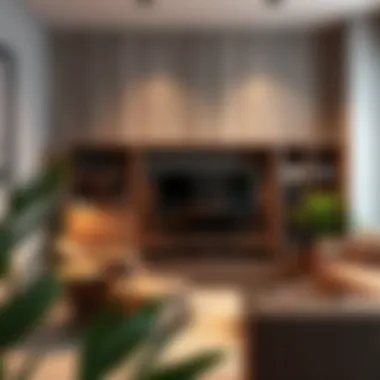
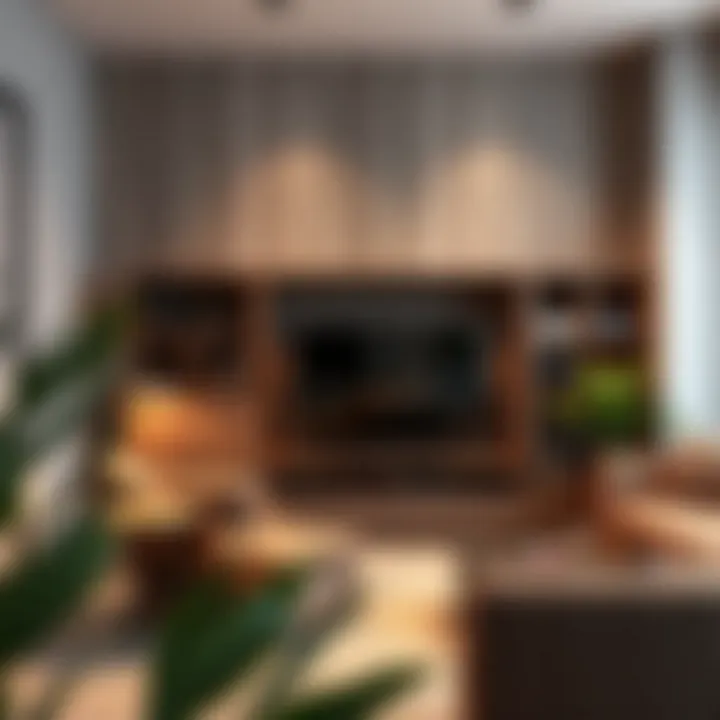
Intro
In the realm of interior design, the emphasis has dramatically shifted towards optimizing space and enhancing aesthetic appeal simultaneously. Corner cube units stand out as a prime solution in this context, cleverly designed to utilize often overlooked corners of rooms. The magic of these units lies not just in their functional prowess but also in their ability to elevate the overall style of a space. This article aims to probe deeper into the multifaceted world of corner cube units, examining their design principles and varied applications in modern living environments.
Furniture Design Trends
As homeowners and designers continually seek innovative solutions, the corner cube unit has emerged at the crossroads of aesthetics and functionality. Integrating elements of current furniture design trends can add significant value to your space.
Trending Materials and Textures
Today’s corner cube units are made from a variety of materials. Here are some that are gaining traction:
- Wood: Timeless and sturdy, options like reclaimed oak and walnut are becoming favorites.
- Metal: Steel frames apply a sleek industrial vibe, often paired with wooden surfaces for contrast.
- Upholstery: Soft, textured fabrics like velvet or linen add comfort and warmth to the very angular designs of cube units.
This combination opens the door to a host of exciting textures, catering to both minimalist and eclectic designs.
Color Palettes and Styles
Color selection plays a pivotal role in defining how a corner cube unit fits within a larger scheme. Trending colors include:
- Earthy tones: Warm, natural hues provide a grounding effect.
- Bold colors: Daring shades like deep blues or emerald greens can serve as focal points.
- Neutral shades: Grays and whites resonate with a clean aesthetic, neutral enough to fit any room.
Styles are equally diverse, from contemporary and mid-century modern to bohemian and industrial, allowing for endless customization to match individual tastes.
"Incorporating corner cube units isn’t merely about filling space; it’s an artistic expression that enhances the room’s narrative."
Practical Tips for Furniture Selection
Selecting the right corner cube unit involves a delicate balance between functionality and aesthetics. Here are guiding principles to consider:
Assessing Space and Functionality
Before making a purchase, it’s crucial to evaluate the space. Consider:
- Dimensions: Measure the corner space to ensure the unit fits without overwhelming the room.
- Purpose: Identify what functions the unit will serve (e.g., storage, seating, display).
Balancing Aesthetics with Comfort
While looks matter, comfort should never take a back seat. Ensure that:
- The materials are inviting, especially if the unit serves as seating.
- The design complements the existing furniture for visual harmony.
Understanding the Corner Cube Unit
Understanding the corner cube unit is a vital piece of discussions around modern interior design, particularly for those aiming to optimize space and aesthetics in their homes. These units, known for their distinctive geometric shape, serve both functional and decorative purposes, making them a noteworthy addition to various settings. When designed thoughtfully, corner cube units can significantly enhance not only the flow of a room but also its overall charm.
Definition and Concept
A corner cube unit can be defined as a type of furniture specially designed to fit snugly into the corners of a room. Much like a puzzle piece, it fills otherwise wasted space, allowing for maximized functionality. These units come in various forms, from bookshelves to display cases, and can also include seating arrangements. The beauty of corner cube units lies in their inherent versatility. They can serve multiple functions while contributing a unique design element to an area.
- Flexible Layouts: Their structure permits diverse arrangements within smaller living spaces, offering numerous design possibilities.
- Visual Interest: The cube shape adds a modern and specific appeal which stands out against the lines of traditional furniture.
It’s essential to comprehend that their successful integration into design requires considering both aesthetic aspects and practical uses. Tailoring these units to suit individual style while still addressing functionality can transform a standard living area into an efficient and inviting haven.
Historical Context
The historical context of corner cube units reflects broader trends in furniture design and space management. Historically, designers and architects have always sought new ways to optimize space, especially as urban living conditions changed—small apartments demanded innovative solutions.
In the early 20th century, with the rise of minimalism and functional design, furniture began evolving to meet not only the needs of the occupant but also the limitations of their spaces. Corner cube units emerged prominently in mid-century modern design, focusing on clean lines and functional aesthetics. This period saw an explosion of modular designs that catered to dynamic living environments.
By the late 20th century, designers like Charles and Ray Eames incorporated the principles of function and form into their designs, paving the way for future innovations in furniture that prioritized both style and practicality. Today, corner cube units continue being refined, balancing traditional craftsmanship with modern requirements to suit various lifestyles. Understanding this historical trajectory allows homeowners and designers to appreciate the evolution and relevance of corner cube units as not just functional pieces but as reflections of changing aesthetic values and living needs.
Design Principles of Corner Cube Units
When considering the integration of corner cube units into a living space, it's essential to understand the underlying design principles. These principles not only enhance the visual appeal of a room but also play a crucial role in maximizing functionality. This section delves into the key elements that define corner cube units—proportions and dimensions, aesthetic considerations, and functional versatility—all of which contribute to making them a unique furniture option.
Proportions and Dimensions
Proportions and dimensions are the backbone of any effective design scheme. With corner cube units, getting these aspects right is crucial for harmonizing with the overall layout of a room.
In essence, the dimensions of a corner cube unit must reflect the scale of the surrounding furniture. Too large, and it overwhelms; too small, and it underwhelms the corner it occupies. Striking the right balance enhances the spatial dynamics. For instance, a larger unit can act as a focal point in a small room, whilst smaller cubes fit seamlessly in more expansive spaces without blocking sight lines or flow.
When sizing a corner cube unit, consider:

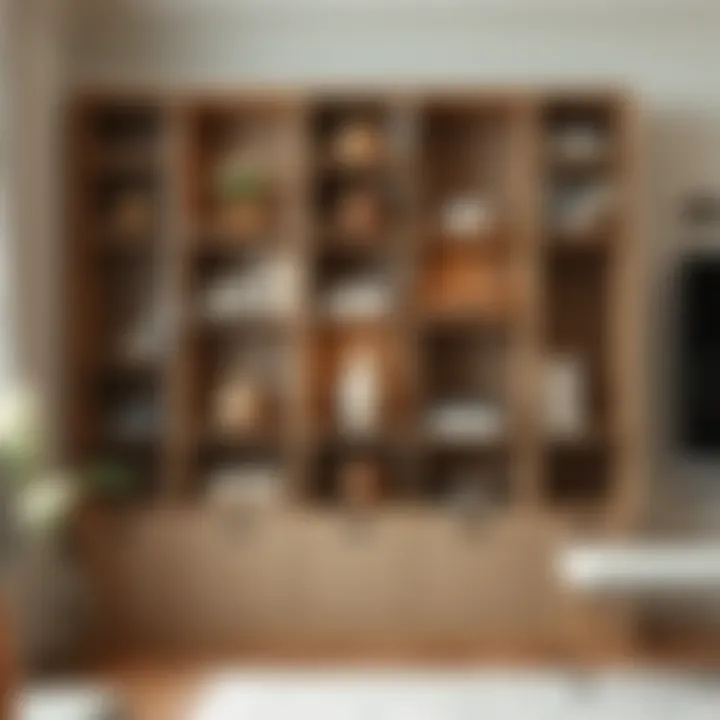
- Height: Tall units can draw the eye upward, making ceilings feel higher.
- Width: A wider unit can act as a shelf or a display area, encouraging functionality.
- Depth: The depth affects ease of use. Too deep and it becomes impractical; too shallow and it might lack purpose.
These proportions should align with personal preferences and intended use, ensuring that the corner cube does not only accentuate the room aesthetically but serves a practical purpose too.
Aesthetic Considerations
The aesthetic influence of corner cube units cannot be overstated. They possess the power to elevate a space’s design by introducing unique shapes and materials. Aesthetics hinge on color, texture, and overall design cohesion.
Consider the following:
- Color Choices: Neutral colors often provide versatility, allowing for easy incorporation with existing decor. Bold colors can make a statement—ideal for a quirky style.
- Texture Variations: Mixing textures—smooth glass with rough wood—creates depth and interest. Texture can also impact perceived warmth or coldness in space.
- Shape Integration: Corner cube units can be square or slightly angled, providing dimensional variety. An angled cube can soften the lines in a room filled with angular furniture.
By choosing wisely, homeowners can create a visual flow that binds a room together, using corner cube units as pivotal design elements.
Functional Versatility
Perhaps one of the most compelling features of corner cube units is their functional versatility. These units do not merely serve as aesthetic embellishments; they can fulfill multiple purposes within a space.
A well-designed corner cube unit can function as:
- Storage: With shelves and compartments, they can keep clutter at bay while looking stylish.
- Display Areas: Perfect for showcasing books, plants, or decorative objects, effectively utilizing space that would otherwise be ignored.
- Seating Solutions: Certain designs enable them to double as seating, an efficient use of space especially in tight areas.
The adaptability of corner cube units makes them suitable for various settings—living rooms, offices, or even bedrooms. This functional versatility can be a game-changer in urban living conditions where space is often at a premium. Through strategic placement and thoughtful design, corner cube units can transform corners from a neglected afterthought into an integral part of a well-designed home.
“In the world of design, the corners are not the ends; they are the beginnings of creativity.”
Understanding the design principles of corner cube units ensures homeowners and designers can make informed choices that marry functionality and aesthetics, leading to enriched living environments.
Applications in Various Spaces
The corner cube unit is more than just a piece of furniture; it's an innovative solution to the perennial woes of space management and aesthetic enhancement. Its versatility makes it an ideal choice for virtually any room in a home, streamlining the functionality and contributing to the overall design. Each application of a corner cube unit can fulfill specific needs while employing the unique characteristics of that space. To make the best use of these units, homeowners and designers alike must consider the layout, purpose, and aesthetic goals of their rooms.
Living Rooms
In the heart of a home, the living room serves as the go-to space for relaxation and socializing. Here, the corner cube unit can act as an anchor point where style meets practicality. Imagine a sleek corner cube that not only houses decorative knick-knacks but also doubles as a tucked-away storage option for throws or books. The flexibility in design allows for varying heights and depths, which can create visual interest without overwhelming the room.
When selecting a corner cube unit for a living room, it's essential to consider the colors and materials already present in the space. A light wood finish can offer a warm, cozy feel, while a metal frame can bring an industrial edge. This choice directly influences the room’s atmosphere, determining whether it feels inviting or austere.
Moreover, arranging seating around a corner cube unit can create intimate conversation areas. Angling the unit in such a way that it forms a natural delineation of space allows for easy flow within the room, transforming it into a multipurpose area for entertainment and relaxation.
Home Offices
In today’s work-from-home culture, a home office needs to be an efficient yet inspiring environment. Corner cube units fit seamlessly into smaller or awkward spaces. They provide essential functionality while also allowing for creativity in decor. Imagine a well-organized unit that stores files on one side and holds a few potted plants on the other. Not only does it declutter your workspace, but it also fuels productivity by integrating natural elements that can invigorate your focus.
Positioning the corner cube unit correctly can enhance the flow of the office. It's smart to pair it with ergonomic furniture to ensure comfort—after all, if you’re spending hours here, you want to be as productive as possible without straining your back. Choosing materials that are easy to clean and maintain will keep the environment tidy, which is crucial when striving for a clear mind and organized tasks.
Bedrooms
The bedroom is a sanctuary designed for rest and rejuvenation. However, it often becomes a catch-all space that can feel cramped and cluttered. Here’s where a corner cube unit can come into play. Think of a cube that not only serves as a bedside table but also provides handy storage for everything from books to extra bedding. It’s about maximizing every square inch to foster a sense of calmness and order.
Additionally, the placement of corner cube units can encourage better flow within the room. A well-placed unit can frame the bed nicely, enhancing visual appeal. Textured fabrics, such as plush cushions or a woven throw carelessly draped, can soften the overall look, creating an inviting space for relaxation.
Entryways
Often the first impression of a home, entryways face the challenge of both function and aesthetics. Corner cube units can be a game-changer here. Picture a sleek, stylish unit that offers a perch for slipping on shoes and baskets for storing umbrellas or gloves. It’s a welcome place that balances the elegance of design with practical utility.
When selecting for an entryway, it’s wise to consider durability since this area will see considerable foot traffic. Using robust materials that can withstand daily use while also looking good is crucial. A corner cube with hooks for keys or a small shelf for mail can keep the entryway organized, ensuring your home remains clutter-free.
"The function of a piece is often as crucial as its form, especially in spaces that set the tone for the rest of the home."
In summary, the corner cube unit represents a smart solution to common design challenges across various rooms. By thoughtfully integrating these units into living rooms, home offices, bedrooms, and entryways, homeowners not only optimize their spaces but also enhance their daily living experience.
Material Selection for Corner Cube Units
Choosing the right materials for corner cube units is crucial, as they not only affect the aesthetic appeal and durability but also influence the overall functionality of the piece. Each material carries unique characteristics that can enhance or limit its use in various spaces.
When selecting materials, homeowners and designers must consider factors such as style preferences, maintenance needs, and environmental impact. These decisions can significantly affect how well the corner cube unit integrates into the existing decor while serving its intended purpose effectively.
Wood Options
Wood is a classic choice when it comes to corner cube units, appealing to those who appreciate natural beauty. The warmth and texture of wood bring a sense of homeliness. Different types of wood offer varying aesthetics and functionalities:
- Oak: Known for its durability and resistance to wear, oak is an excellent choice for furniture that needs to stand the test of time. Its natural grain adds visual interest.
- Maple: This wood provides a smooth texture and is less prone to scratches, making it a suitable option for families with young kids.
- Walnut: With its rich, dark color, walnut adds elegance and a touch of sophistication. It is often favored for more upscale designs.
However, wood requires some maintenance like regular polishing and careful cleaning to preserve its finish, which can be a consideration for some homeowners.
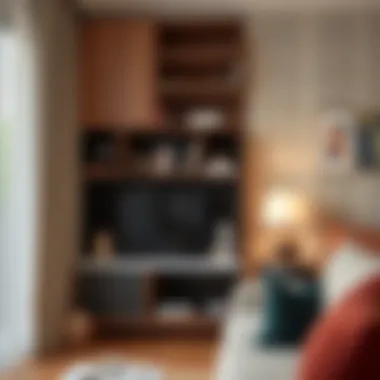
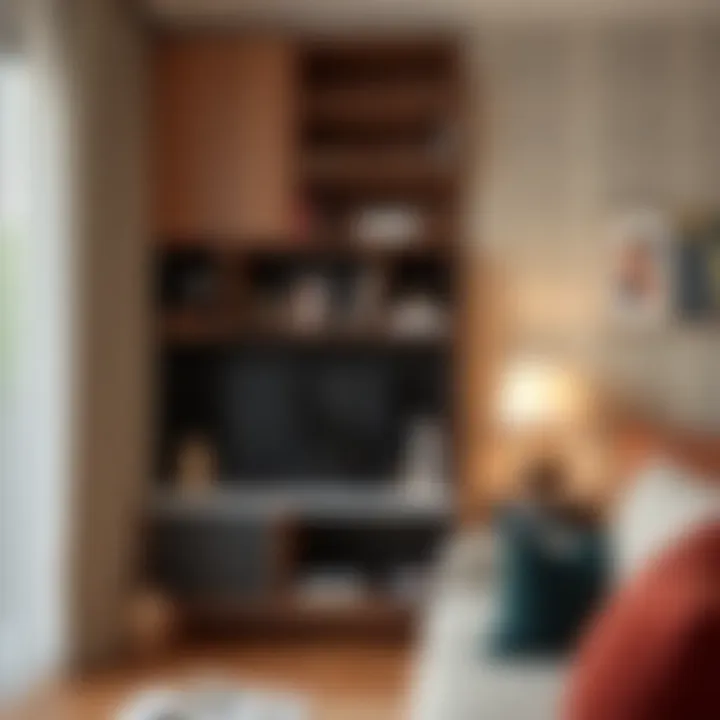
Metal Frames
Metal frames bring a modern flair to corner cube units, offering a sleek and minimalist look. The use of metal allows for enhanced structural integrity and a lightweight design. Common metals used in furniture design include:
- Steel: Renowned for its strength and longevity, steel frames can withstand significant weight, making them ideal for supporting heavier components like shelves or drawers.
- Aluminum: Lightweight and highly resistant to corrosion, aluminum is a solid choice for those seeking both style and practicality. It’s often used in contemporary designs.
- Iron: For a vintage or rustic vibe, wrought iron provides an antique aesthetic while being incredibly sturdy.
The metallic finish can easily complement a variety of styles, but be aware that metals may retain heat or cold, impacting comfort depending on room temperature.
Glass Accents
Incorporating glass accents can significantly elevate the visual appeal of corner cube units. Glass adds transparency and lightness, often making spaces feel larger and more open. Here are some key points regarding glass use:
- Tempered glass: This is a safer option as it is less prone to shattering. It is ideal for shelves that require an airy feel but still need to support considerable weight.
- Frosted glass: Offers a modern aesthetic while providing some privacy, making it a perfect choice for units in shared living areas.
- Laminated glass: Provides extra durability and can withstand scratches and impact, making it a practical choice for high-traffic areas.
Integrating glass can also simplify cleaning, as it usually requires just a simple wipe-down to maintain clarity, unlike more porous materials.
Selecting the right materials for corner cube units is not just about aesthetics; it also involves understanding their durability, functionality, and maintenance requirements.
The successful blend of these materials can result in corner cube units that are not only beautiful but also serve as functional cornerstones in your space, enhancing both style and practicality.
Color Schemes and Textures
In the realm of interior design, color schemes and textures are pivotal elements that contribute to the overall mood and functionality of a space. They serve not only to beautify but also to create a welcoming atmosphere conducive to living and working. When it comes to incorporating corner cube units, understanding how these two factors interplay can dramatically enhance their impact. A well-thought-out color palette paired with the right textures can transform a mere addition to a striking centerpiece that ties the room together.
Monochromatic Approaches
Monochromatic schemes involve the use of varying shades and tints of a single color. This approach can make a room appear more expansive while ensuring a cohesive look. Suppose a homeowner opts for shades of blue in their corner cube unit; the lighter tones can reflect light and create a sense of openness. This simplicity is not only serene but also sophisticated.
Using a monochromatic approach can minimize visual clutter, allowing the corner cube unit’s design to shine. It's essential, however, to consider texture variations. For instance, a smooth matte paint against a sleek wooden finish can add dimension without straying from the singular color theme. The interplay of light on these textures adds an intriguing depth that keeps the design dynamic.
Contrasting Palettes
In other scenarios, contrasting palettes wield their magic by pairing bold colors against more subdued ones. This method can energize a space, making it lively and visually exciting. When setting up a corner cube unit against a backdrop of soft grays, a rich navy or vibrant mustard yellow can create a striking visual focal point.
This contrast can guide the eye around the room, enhancing the sense of space. It's crucial to be mindful of the balance; too much contrast can overwhelm. Instead, introducing accents in smaller furniture or decor can help ground the room. Consider using neutral tones for surrounding walls while allowing the cube unit to pop with color, thereby emphasizing its functionality as well as style.
Incorporating Patterns
Patterns are another layer to consider when dressing up corner cube units. They bring personality to a space, but moderation is key to avoid chaos. For example, a cube unit in a solid color paired with patterned pillows or decor can add visual interest without overdoing it. Mixing geometric shapes with soft, organic patterns can achieve a compelling juxtaposition that keeps the eye engaged.
Utilizing wallpaper or textiles with brick or striped designs on adjacent walls can create a sense of cohesion with the corner cube unit, effectively integrating it into the overall decor. The key here is to ensure that the patterns chosen to complement the corner unit meld naturally with the other elements present in the room rather than clash.
The choice of color schemes and textures is crucial, as they can elevate a corner cube unit from an ordinary piece of furniture to a statement-making fixture in your home.
In summary, a strategic approach to color schemes and textures can vastly improve how corner cube units fit into and enhance a given space. Homeowners and designers alike can experiment with monochromatic schemes for a serene atmosphere, embrace contrasting palettes for a more energetic look, or integrate patterns to instill personality and charm. These choices will ultimately shape the ambiance of modern living environments, leaving a lasting impression on all who enter.
Styling the Corner Cube Unit
Styling the corner cube unit is not just about what looks good; it’s about how it brings a room together, enhancing both its functionality and aesthetic appeal. These units can serve as a unique focal point, making the best use of limited space while adding a touch of flair. Instead of just filling a corner, they can transform an otherwise neglected area into a functional and stylish element in the room. With thoughtful styling, you can reflect your personality and create a welcoming atmosphere that resonates with anyone who enters the space.
Accessorizing for Functionality
Accessorizing is key to ensuring your corner cube unit is more than just a decorative piece. Choosing functional accessories allows the unit to serve multiple purposes. For example, incorporating storage baskets made of natural fibers can add warmth and texture while keeping items tidy and accessible. Using decorative trays can help organize small items such as keys or mail, making it practical for an entryway.
More specifically:
- Use baskets: These can fit neatly within the cube for an unorganized clutter.
- Trays and organizers: They keep things tidy and in sight but don’t overwhelm the visual space.
- Books or magazines: Stacking some of your favorite reads not only adds interest but also makes the unit functional.
By thoughtfully curating accessories, you ensure the corner cube unit serves its purpose effectively, striking a balance between form and function.
Layered Textures and Elements
Layering textures provides depth to your corner cube unit and can drastically change the room’s dynamics. Whether you choose plush textiles, smooth finishes, or rustic wood, combining these materials can create a captivating visual experience and enhance tactile appeal.
You might think about:
- Textiles: Adding a soft throw or decorative pillows can invite comfort. Space can feel more inviting when textiles contrast with the hard surfaces of wood or metal on the unit.
- Natural elements: Incorporating plants can introduce life and softness to a design. An indoor plant in a stylish pot can break up the sharp edges typical of furniture pieces.
- Varying heights: Arrange items of different heights to draw the eye upward, creating an inviting and engaging sight-line.
When these layers create a harmonious relationship, the corner cube can become a central conversation starter rather than a mere piece of furniture.
Art and Decor Integration
Integrating art and decor into your corner cube unit can elevate its presence and underscore your style. Art is not limited to pictures or sculptures; decor includes diverse elements that reflect your individuality.
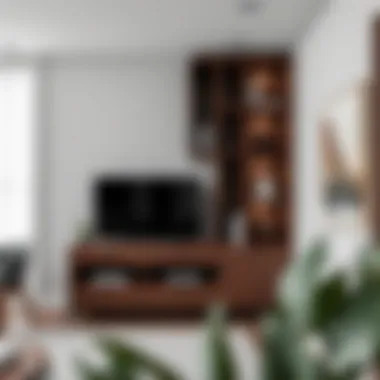
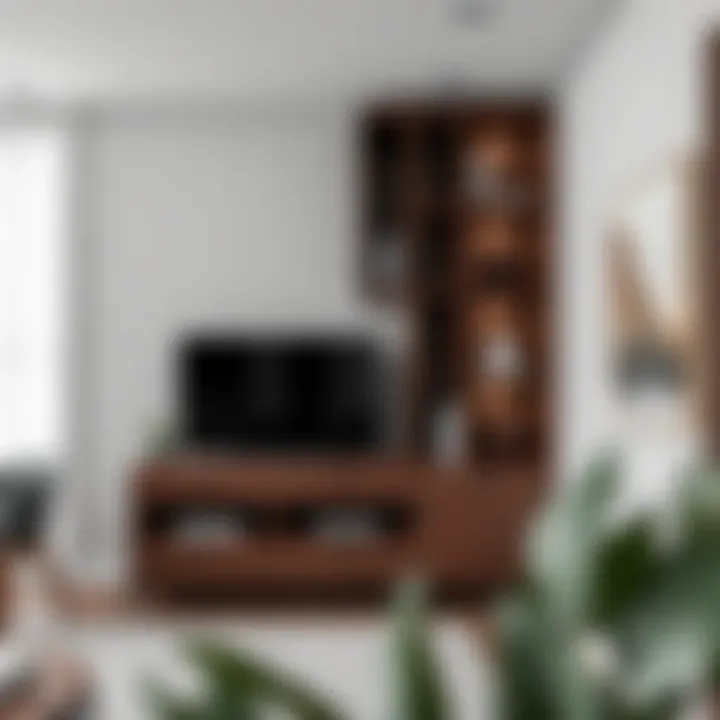
Ideas for effective integration include:
- Framed artwork: Leaning a small framed piece against the wall on the cube unit can create a gallery feel without the need for nails or hooks.
- Personal collectibles: Items that hold personal significance often tell a story and can engage visitors, transforming a simple unit into a narrative landscape.
- Seasonal decor: Changing the decor based on the seasons keeps the space fresh and reflects the warmth of each time of year.
"The integration of art within functional furniture transforms spaces into realms of personal expression rather than mere utility."
Successfully blending art and decor not only augments the aesthetic appeal of the corner cube unit but also allows it to play a role in the broader narrative of your living space.
Challenges and Considerations
Furnishing a space efficiently brings along its own unique set of challenges, particularly when integrating corner cube units. These versatile pieces can significantly enhance both the functionality and aesthetic appeal of a room. However, potential obstacles cannot be ignored. It’s essential to tackle issues such as limited space, styling dilemmas, and endurance of materials to get the most out of your furniture choices.
Space Limitations
When dealing with interior design, space is often the elephant in the room. Corner cube units, while designed to maximize often neglected areas, still need to fit into the overall dimensions of your space. If not carefully measured, a corner cube unit can quickly become a clunky annoyance rather than a sleek addition. For instance, it’s crucial to consider how much actual room you have in the corner where you want to place the unit—this includes measuring the wall lengths and accounting for any nearby furniture or fixtures that might impede accessibility or aesthetics.
- Consider the following:
- Dimensions: Ensure the height, width, and depth of the unit won’t overwhelm or underwhelm the surrounding area.
- Harmonizing with Adjacent Furniture: Ensure it complements existing pieces rather than clashing with them.
- Functionality: Gauge whether the corner cube unit serves a practical function that justifies its placement.
Styling Dilemmas
Another aspect to consider is the styling of the corner cube unit, which can pose its own challenges. Balancing a corner piece within the broader decor scheme requires a good eye. It’s easy to fall into the trap of overcrowding the space with mismatched accessories or failing to integrate it into your overall design concept. Finding a balance is key.
- A few pointers to avoid pitfalls:
- Color Coordination: Pair the unit with colors that harmonize with the room’s palette, avoiding the temptation to implement too many contrasting hues.
- Accessorization: Choose accessories wisely. For example, if you’ve adorned the unit with books and ornamental items, ensure they don’t crowd the space, as this could lead to a visually jarring effect.
- Functional and Aesthetic Balance: Remember that while a unit can look good, it should also maintain its purpose—storage, display, etc.
Maintenance and Durability
Lastly, the longevity of your corner cube unit hinges on material selection and what regular upkeep it entails. As styles evolve, so do the needs for durability and ease of maintenance. If a unit looks fabulous but requires constant care, it might not be a savvy investment.
- Here are some common considerations:
- Cleaning Requirements: Choose materials that are easy to wipe down or treat, especially in high-traffic areas.
- Endurance: Look for durability in the material. For example, certain woods or metal finishes can resist scratches better than others.
- Lifestyle Compatibility: Assess whether the unit’s materials fit your lifestyle. If you have children or pets, for instance, what seems appealing might not be practical.
In closing, while challenges associated with corner cube units exist, they can be navigated efficiently with careful planning, consideration, and a discerning eye for complementary design elements. In the end, ensuring these factors are taken into account can lead to splendid results, making your corner a little haven of style and functionality.
Future Trends in Corner Cube Units
As we move further into the 21st century, the landscape of furniture design and functionality is undergoing a transformation. The corner cube unit is at the forefront, enhancing both space management and aesthetic appeal. This piece of furniture is not merely a static element; it adapts and evolves, mirroring shifts in design philosophies, technological advancements, and environmental consciousness. Understanding these future trends can provide homeowners and designers with insights that are essential for making informed choices.
Sustainable Materials
In an era where sustainability is not just a buzzword but a pressing need, corner cube units increasingly incorporate eco-friendly materials. These materials may include bamboo, reclaimed wood, and recycled metals, all of which significantly reduce the carbon footprint compared to traditional options.
- Bamboo: Known for its rapid growth and renewability, bamboo is a fantastic choice for those pursuing sustainability. It boasts durability while offering warmth and aesthetic appeal.
- Reclaimed wood: This material tells a story, adding character and history to the corner cube unit. Each piece might have unique markings, providing a sense of individuality to any room.
- Recycled metals: By using metal sourced from old furniture or buildings, manufacturers are making strides toward a more circular economy. This not only supports the environment but also ensures that the corner cube unit has a robust structure.
By choosing sustainable materials, homeowners can create a positive impact that transcends their immediate living environment, encouraging a more responsible approach to consumption.
Smart Furniture Innovations
Technology has seeped into every facet of our lives, and furniture design is no exception. Corner cube units are beginning to embrace smart technology, marrying traditional aesthetics with modern conveniences.
- Integrated charging stations: Many corner cube units now include built-in outlets and USB ports, ensuring that devices are always powered up.
- Modular designs: Consumers have come to appreciate flexibility. Modular corner cube units allow for a customized approach, where pieces can be rearranged or expanded as needs change.
- Smart sensors: Imagine corner cube units that can detect room brightness and adjust lighting accordingly, or ones that can connect to smart home systems for climate control. These features can add layers of convenience, enrich the living experience, and enhance energy efficiency.
The fusion of technology and design does not just cater to contemporary aesthetics; it persuades homeowners to reconsider how they engage with their living spaces. Integrating smart features into the design of corner cube units presents opportunities for a more connected and efficient home environment.
"The future of furniture is not merely in its functionality or style, but in its ability to adapt to our evolving needs and lifestyles."
By embracing these trends—sustainability and smart innovations—corner cube units stand out not only as functional assets but as conscious choices reflecting overarching values about living and design. In turn, they carve out a new identity for what furniture can be in contemporary settings.
End
In wrapping up the discussion on corner cube units, it becomes clear why this topic holds significant weight in the realm of interior design and space management. These versatile units are not just about aesthetics; they serve as crucial tools for optimizing available space, blending functionality with style in a seamless manner.
Summarizing Key Insights
Corner cube units offer a unique approach to furniture design, effectively utilizing corners that often go neglected. Key points worth highlighting include:
- Versatile Usage: Corner cube units can adapt to a variety of styles and functions. Whether you use them for storage, as display shelves, or as part of a cozy reading nook, their purpose can suit the requirements of any room.
- Material Diversity: From wooden designs that convey warmth to metal and glass that evoke a modern vibe, the material choices provide flexibility in achieving desired aesthetics.
- Space Efficiency: Particularly valuable in smaller living environments, corner cube units enable clever storage solutions that keep areas tidy without sacrificing comfort or style.
These insights present a solid foundation for anyone considering the incorporation of such units into their space. The multifaceted design is not only appealing but also practical, making them worthy of consideration for any homeowner or designer aiming to maximize impact.
Final Thoughts on Integration
When contemplating the integration of corner cube units into your living space, consider this: the goal should be to strike a balance between utility and design. Emphasize how these units can harmonize with existing elements, enhancing the overall feel of the area. Specific things to ponder include:
- Placement: Pay attention to where the unit is situated. A good spot can elevate the entire room, transforming what would be an overlooked corner into a focal point.
- Personal Style: Whatever your taste is, make sure the unit reflects your unique style. This personalization elevates the space from merely functional to truly expressive.
- Future Proofing: As styles and needs evolve, so too should your furniture choices. Investing in a corner cube unit that can adapt through different uses or styles will ensure longevity in its application.



